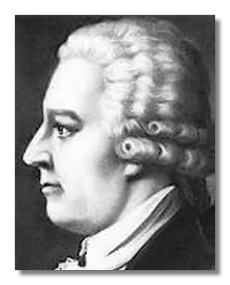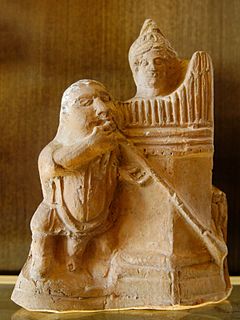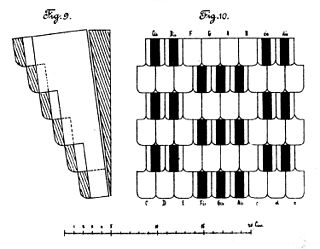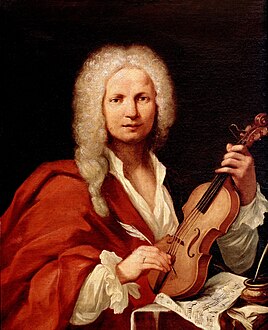
The theremin is an electronic musical instrument controlled without physical contact by the thereminist (performer). It is named after its inventor, Leon Theremin, who patented the device in 1928.

Johann Schobert was a composer and harpsichordist. His date of birth is given variously as about 1720, about 1735, or about 1740, his place of birth as Silesia, Alsace, or Nuremberg. He died after eating poisonous mushrooms that he insisted were edible.

The wind machine is a friction idiophone, which is a class of instrument which produces sound through vibrations within the instrument itself. It is a specialist musical instrument used to produce the sound of wind in orchestral compositions and musical theater productions.
Paul Arma was a Hungarian-French pianist, composer, and ethnomusicologist.

A salpinx was a trumpet-like instrument of the ancient Greeks.

Paul von Jankó was a Hungarian pianist and engineer.

Tito Manlio is an opera in three acts by Antonio Vivaldi, to a libretto by Matteo Noris. It was written in celebration of the marriage of Philip of Hesse-Darmstadt (1671–1736), the governor of Mantua, which he had announced at Christmas. Vivaldi quickly composed the opera within five days. Whereas the wedding eventually did not take place at all, the opera was successfully premiered at the Teatro Arciducale ‘detto il Comico’ in Mantua during the carnival season of 1719.
Nikolai Vladimirovich Shcherbachov was a Russian composer and pianist.
Luis Misón was a Spanish composer. Born in Mataró, Barcelona, he composed over 100 tonadillas, including Una mesonera y un arriero, which contains the song "Seguidilla dolorosa de una enamorada" ("Painful song of a girl in love", Los ciegos, and El maestro de baile.
Thomas Haxby was an English instrument maker, particularly of keyboard instruments, including harpsichords, pianos, and organs.

Philip of Hesse-Darmstadt was a Prince of Hesse-Darmstadt, Imperial Field marshal and Governor of Mantua.
Friedhelm Döhl was a German composer and professor of music.
Joseph Beer was one of the first internationally famous clarinet virtuosos, with connections to many major composers of the era.

Nikolai Borisovich Obukhov was a modernist and mystic Russian composer, active mainly in France. An avant-garde figure who took as his point of departure the late music of Scriabin, he fled Russia along with his family after the Bolshevik Revolution, settling in Paris. His music is notable for its religious mysticism, its unusual notation, its use of an idiosyncratic 12-tone chromatic language, and its pioneering use of electronic musical instruments in the era of their earliest development.

The ondes Martenot or ondes musicales is an early electronic musical instrument. It is played with a keyboard or by moving a ring along a wire, creating "wavering" sounds similar to a theremin. A player of the ondes martenot is called an ondist.
Columba Aspexit is a sequence written by Hildegard of Bingen in the late 12th century. It is one of seven sequences from her collection of lyrical poetry entitled Symphonia armonie celestium revelationum. This piece is found in only one manuscript: HS 2; Hessische Landesbibliotek, Wiesbaden, “Riesenkodex” (1175).

An Ilú or Ilu is the Yoruba name for a type of Brazilian wooden folk drum, found characteristically in the northern provinces of Pernambuco and Ceará.
The Divertimento in G major, Hob. XVI/8, L. 1, was written in 1766 by Joseph Haydn.
"Let Evening Come" is a poem by Jane Kenyon.










